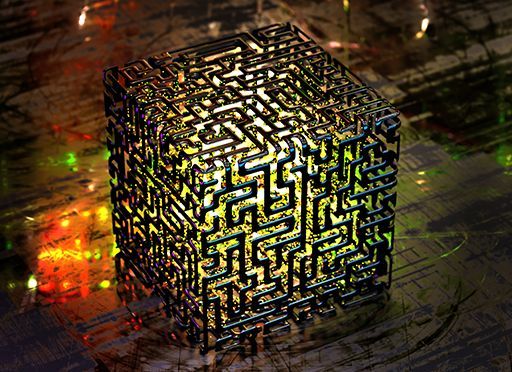Quantum Computing Gets Real
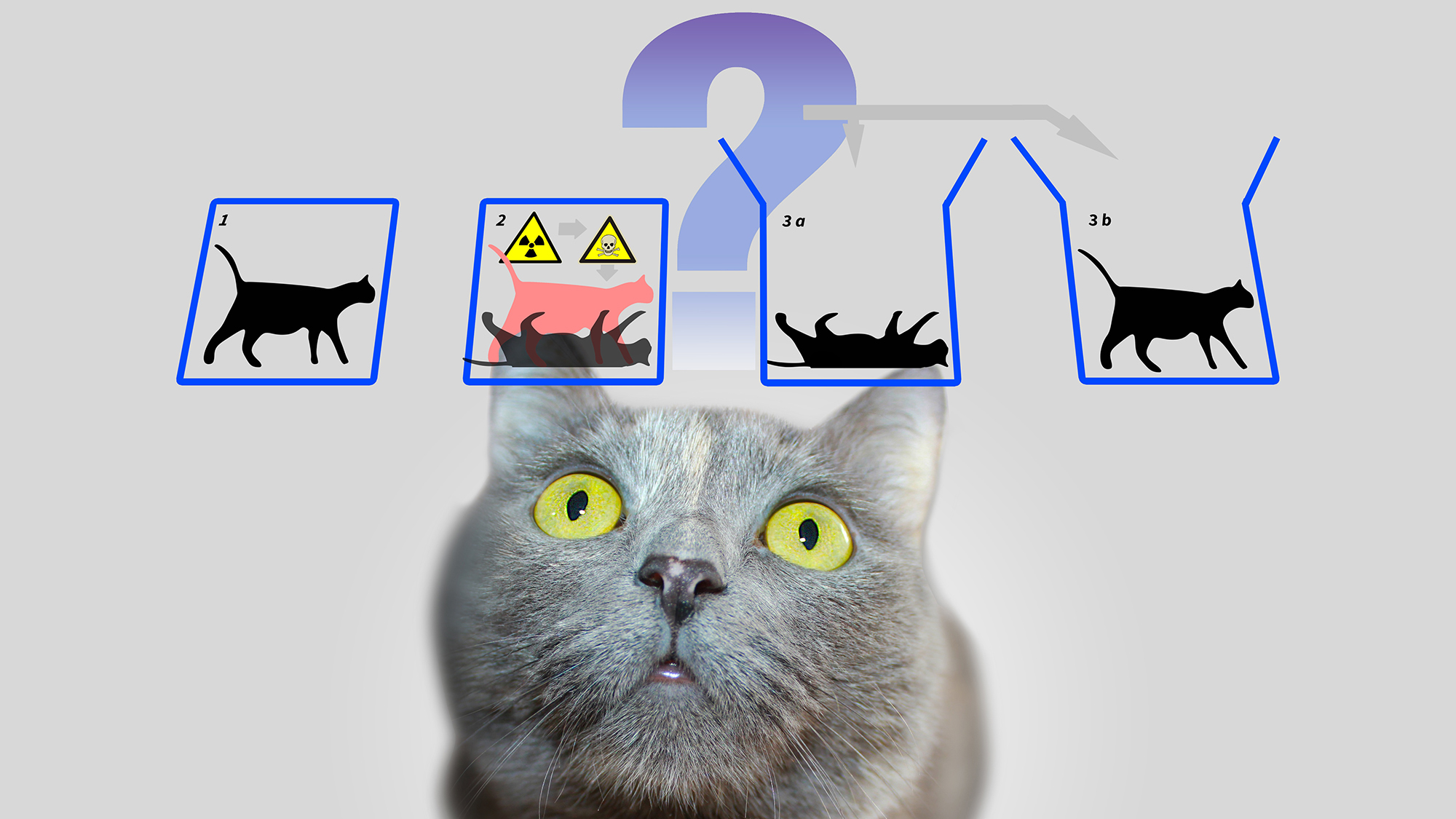
Quantum mechanics disrupted classical physics when, in the early 20th century, Niels Bohr first described the ways that atomic behavior diverges from the behavior of larger matter. When science journalist Julian Brown wrote Minds, Machines, and the Multiverse in 2000, quantum computing was a tantalizing theoretical notion. He opined then that it would signal a greater leap in technological evolution than “the one from the abacus to the supercomputer.” Now, that incredible potential is becoming visible.
1. Science Doesn’t Know Exactly Why Quantum Mechanics Works
Quantum computing is based on the laws of quantum mechanics, which is a branch of physics that describes phenomena at the atomic level, where light can be a particle or a wave. In fact, it’s actually both at the same time, unless someone observes it. In quantum theory, the science gets weird right away.
Trying to explain the mechanics that underlie quantum computing can make even physicists crazy. Erwin Schrödinger, who developed the mathematics of light waves, demonstrated the absurdity of quantum mechanical paradoxes with a famous thought experiment. What if he put a cat in a box rigged in such a way that if a sensor detects radioactivity it will open a vial of cyanide and kill the cat? As Adam Becker explains in What Is Real?, radiation obeys quantum rules and both will and will not trigger the reaction that both does and does not kill the cat until someone takes a look, which is absurd.

Since then, other physicists helped shape quantum theory so it makes more sense. Schrödinger’s cat is either dead or alive before someone observes it because the continuum of possibilities exists somewhere, in some universe, according to the equally strange “many worlds” theory of parallel universes. What?
As you can see, it’s hard to put some of these ideas into words without walking into an intellectual quagmire.
Julian Brown
Bohr and his colleagues asserted subatomic particles could be in two places at the same time and influence each other instantaneously over distances, a phenomenon called “entanglement,” which meant they could travel faster than the speed of light, violating Albert Einstein’s Relativity theory. As the properties of a subatomic particle (which also behaves like a wave) cannot be determined until it is measured, before that they are in “superposition,” a state of potential positions all at the same time. Once measured, a particle is definitely (most probably) in one position.
All you really need to know is, quantum computing preserves this ambiguous state of “superposition” which directly leads to exponentially greater computing power than today’s classical computers can attain. While scientists disagree about exactly what’s going on under the hood, quantum theory works, and the practical applications are sure to astound.
2. Quantum Computers Run Calculations Using Qubits Instead of Bits
Hosts of the Make Me Smart podcast Molly Wood and Kai Ryssdal interviewed director of the Berkeley Center for Long-Term Cybersecurity Steven Weber and helpfully dumbed this complex subject down for us mere mortals. Chips in quantum computers are made up of qubits (quantum bits) rather than the bits that form the basis of classical computing. If the traditional binary language of computers is akin to the two sides of a coin, heads or tails, qubits are like spinning coins. While bits have only two states, on or off, signified by zeroes and ones, qubits operate in “superposition” – multiple states between on and off at the same time – exponentially increasing computational power by orders of magnitude. To achieve this state of “superposition,” qubits must operate at absolute zero with the help of liquid helium and in a stable environment.

Disturbances – even something so seemingly inconsequential as a pin dropped from a few blocks away – can “decohere” qubits, adding to the already considerable errors quantum computing racks up. Improving “fault tolerance” is crucial to expanding quantum computing uses because practical applications will require more qubits. Errors have been virtually eliminated in classical computing environments.
3. Quantum Computing Will Enable Much More Complex Modeling in a Variety of Applications
In “Schrödinger’s Cheetah,” The Economist reports on Google’s feat of demonstrating “quantum supremacy” by solving a problem in three minutes on its quantum computer that would take the fastest supercomputer 10,000 years to solve. NASA joins them in this feat. China also claims reaching a similar milestone and other organizations are surely close. China’s approach manipulates photons rather than freezing qubits.
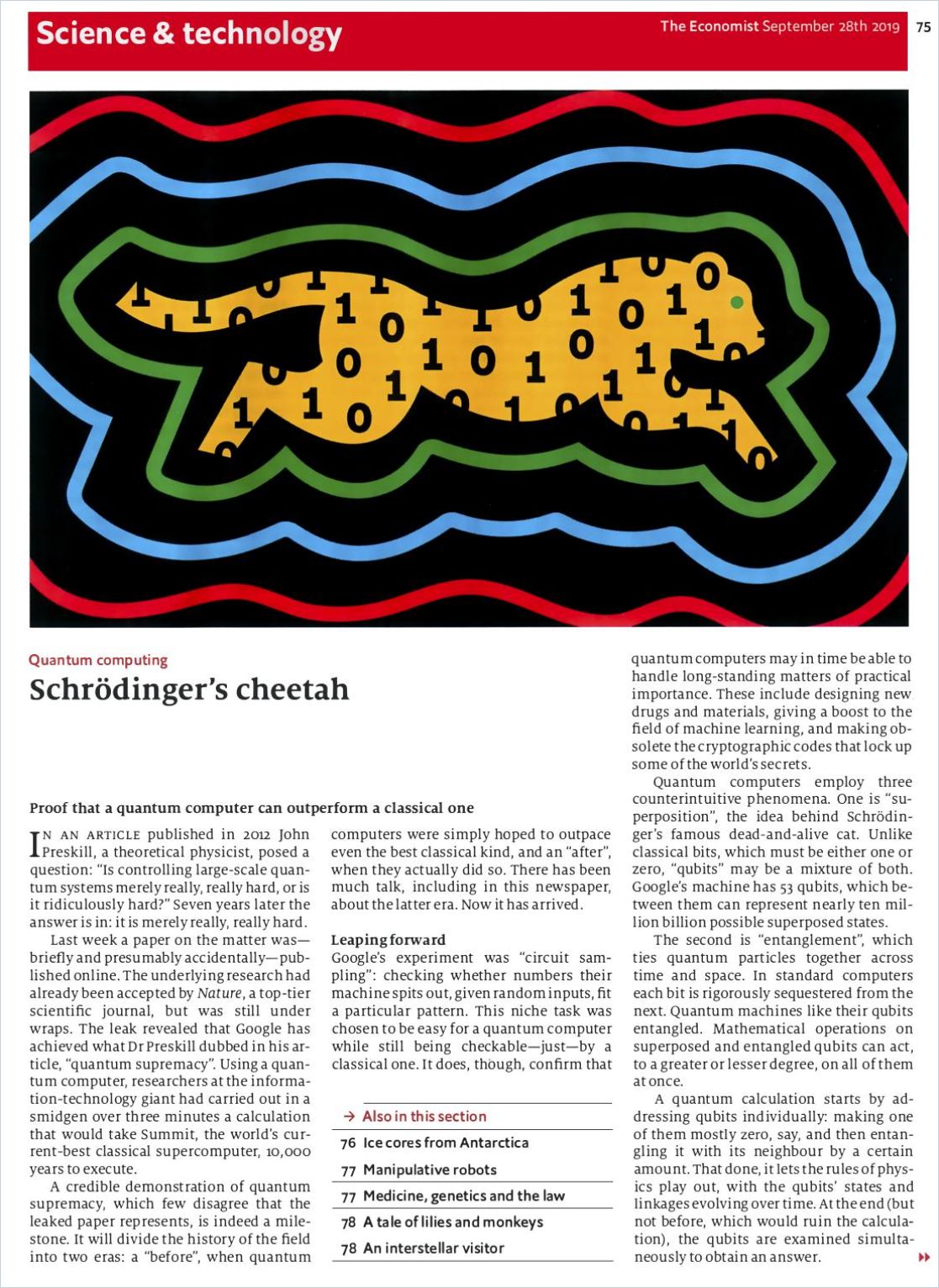
Quantum computing will be able to crunch more data at faster speeds. Most current computer cryptography relies on the difficulty of factoring large numbers, but quantum computing will easily be able to accomplish this feat. The hope is that quantum systems will generate more secure cryptography. The fear is that, for a while at least, those with access to quantum computing power will have an asymmetrical advantage trying to crack conventionally protected digital information.
A world with powerful quantum computers…is one in which much of today’s cybersecurity unravels.
The Economist
The US government endeavors to stay at the leading edge of quantum technologies in order to fend off attacks. As quantum computing moves out of theory and into the realm of possibility, the national security implications multiply. Luckily, because of entanglement, trying to crack “quantum keys” will leave a trace. Once particles are entangled, that link means that information is instantaneously shared between them; some scientists refer to this as “quantum teleportation,” and it forms the basis of more secure next-generation digital communications.
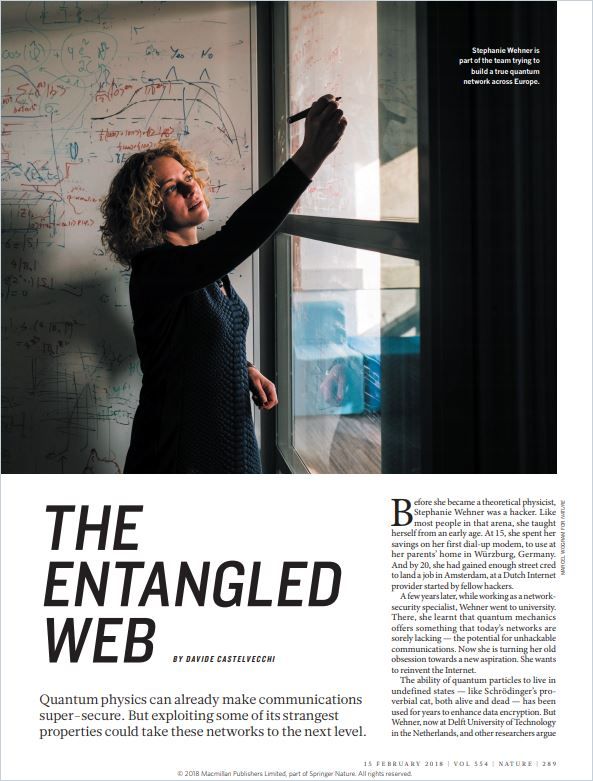
Entanglement causes qubits to behave in tandem, multiplying the information density they can achieve compared to classical computers. Because of the exacting environment qubits need to operate within and their vulnerability to error, the technology faces significant scaling challenges.
A true quantum network would be able to harness entanglement and teleportation to transmit quantum information over long distances, without the need for vulnerable trusted nodes.
Davide Castelvecchi
Quantum computing will be reserved for solving complex problems and doing complex modeling, especially modeling that involves phenomena on the atomic level. Think materials science and drug interactions, medical imaging machines that can visualize molecules. Quantum computing will revolutionize machine learning by dramatically reducing the time it takes to crunch through massive amounts of data and analyze possibilities. Nippon Steel is looking at how quantum computing can help it optimize its supply chain and protect itself during disruptions. Classical computing will still work best for regular business applications such as email, spreadsheets and Zoom meetings and practical usefulness for quantum computing is still a few years away.
4. Quantum Computing Will Unlock Nanotechnologies
Quantum computing makes controlling matter at the molecular level possible. Programmed microscopic machines may soon be able to manipulate genetic code and cure disease. Data storage will continue to miniaturize, though no longer on silicon chips. Nanotechnologies may be the most exciting horizon-line says Steven R. Waite in Quantum Investing.
Our entire global technological superstructure is based on all things quantum – the electron, photons, and other atomic and sub-atomic entities.
Steven R. Waite
Mathematician John von Neumann imagined a “universal constructor” machine that could build anything, given the raw materials. “Nanoassemblers” – tiny robots that could “snap atoms together like Lego blocks” – now seem possible. Nanoparticles already help make materials easier to clean and harder to scratch. Nanotechnology promises new materials and new processes with implications across multiple industries. For example, nanotechnology will revolutionize cancer therapies, allowing doctors to pinpoint cancerous cells with tiny, programmed “smart bombs.”
Whereas modeling penicillin on a classical computer would take 1086 bits, it could take as few as 286 qubits on a quantum computer.
Boston Consulting Group
Quantum computing will turbo-fuel research at atomic levels, being able to simulate the processes that underlie physical phenomena or chemical compounds. Pharmaceutical development is ripe for quantum disruption. Boston Consulting Group predicts quantum computing will blaze inroads for pharmaceutical R&D since qubits can handle the computations involved with analyzing molecular behavior “orders of magnitude” better than the most powerful computers today can.

Will Quantum Computing Transform Biopharma R&D?
The Boston Consulting GroupQuantum computing’s promise is beginning to prove itself in the marketplace, where it can cut time and money in the development of new drugs. Several companies are producing quantum-based hardware and algorithms targeted to the pharmaceutical industry to aid in drug discovery. The entire process, end-to-end, may one day – perhaps by 2040 – happen “in silico” thanks to quantum computing, depending on how quickly researchers can improve fault tolerance. Meanwhile, quantum computing will enhance classical computing every step of the way.
5. Increasing Public and Private Funding Supports a Growing Quantum Computing Ecosystem
As quantum computing improves, scientists can network together their computers with limited numbers of qubits via the cloud to increase power. This will also increase errors; correcting for errors remains a barrier for practical usage.
Although quantum computing offers seemingly unlimited amounts of massive parallelism without the need for extra hardware, there is also a price to be paid: It’s impossible to read all the darned answers.
Julian Brown
Philipp Gerbert and Frank Ruess writing for the Boston Consulting Group Munich, say despite obstacles, quantum computing is coming and they lay out ways for business to evaluate its potential. The field will be shaped by the discoveries happening now and in the next five years. They predict quantum computing to profoundly affect every business’s future.

The Next Decade in Quantum Computing – and How to Play
The Boston Consulting GroupTherefore, keep abreast of the growing “quantum computing ecosystem” and the ways it might make sense for your company to plug into it. IBM, Google, Baidu and others are creating Quantum as a Service (QaaS) cloud computing interfaces. It may make sense to invest in a quantum lab to build institutional experience with quantum computing and understand how this technology may be a game-changer in your industry.
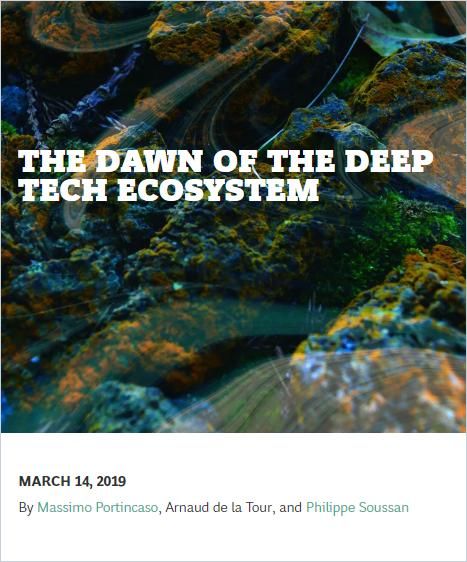
Whoever stakes out the most important business beachheads in the emerging quantum computing technologies will very likely do so over the next few years. The question is not whether or when – but how companies should get involved.
Philipp Gerbert and Frank Ruess
Funding for the “deep tech ecosystem” is heating up, although American investment is falling behind especially China’s investment in this sector, with only 10% annual growth and declining numbers of deep tech firms. Start-ups rely on public funding. Machine learning, genetic sequencing, cloud computing, 3D printing and other emergent technologies of the “fourth industrial revolution” put extraordinary innovative possibilities into reach for entrepreneurial developers. Incubators, universities and public-private collaborations of all stripes characterize the fertile ground for current R&D.
Companies and investors…need to engage with and nurture the entire ecosystem and look for the winning start-up or technology to emerge from it.
Boston Consulting Group
Quantum computers work differently than the computers businesses use today. But you’ll be able to code for quantum computers if you know Python. You can noodle around with quantum computing problems at IBM’s online Qiskit project, which provides an open-source environment via cloud for working with quantum computers. IBM, Google, Amazon, Honeywell and other companies are flocking to the space as quantum computing gets real.
Keep up with developments:
